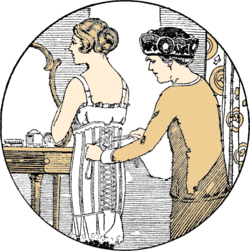Spirella

USA
The name "Spirella" refers to the Spirella Stay which was invented by Marcus Merritt Beeman in 1904 and made from tightly twisted and flattened coils of wire. The founders were Beeman, William Wallace Kincaid and Jesse Homan Pardee.[1] The Spirella name was used by the Spirella Corset Company Inc that was founded in 1904 [2] in Meadville, Pennsylvania, USA. It was founded on a patent of dressbone,[3] for bustles, but started corset manufacture in 1904. The company manufactured made-to-measure corsets. Benefits for the company's employees included travel, education and health care.[4]
Locations
At its height the company had factories in the USA (Meadville, Pennsylvania and New Haven, Connecticut), in Canada (in 1910), in the UK (in 1910; from 1912 in the Spirella Building in Letchworth) and in Sweden (Malmö) in 1920. Their flagship location was Spirella House on Oxford Circus, London. A factory built in 1910 in Niagara falls, Ontario, eventually became the premises of the Bird Kingdom Tropical Adventure.[5]
UK
The UK subsidiary was The Spirella Company of Great Britain. Spirella co-founder and entrepreneur William Wallace Kincaid commissioned the architect Cecil Hignett to design a state-of-the art factory of architectural beauty. The design included embellishments in Arts & Crafts styling. This factory, the Spirella Building, was built and expanded in stages between 1912 and 1920.
During World War II, the Irvin Airchute Company expanded its production of parachutes into the Spirella Building and women working for the British Tabulating Machine Company secretly produced components for the decoding machines called Bombes.[6]
The company's most popular corset was the Model 305. Spirella products were not sold in shops. Instead, female staff called corsetiers (or corsetières) were sent to customers' homes.[7]
After an ill-fated attempt to market garments of "Stub-tex", a form of Gore-Tex being used under licence from W. L. Gore & Associates, the company was sold in 1985 to the rival Spencers of Banbury and finally closed in July 1989.

The Spirella Building provided the perfect environment for his workers to be happy, contented and highly productive, and was worthy of being called "The Factory of Beauty". In 1979 it was Grade ll* listed.[8] The Letchworth Garden City Foundation bought the neglected building in 1995, restored the interior and re-opened it for leased office accommodation.[9]
References
- ^ "Exhibitions". Garden City Collection. Letchworth Garden City heritage Foundation. Retrieved 11 May 2016.
- ^ "Notes on the European Offices". History of Spirella. Retrieved 11 May 2016.
- ^ Julie A. Lauffenberger, "Baleen in Museum Collections", Journal of the American Institute for Conservation (1993), Volume 32, Number 3 (pp. 213 to 230) [1]
- ^ "HM1194". Historical marker Project. Retrieved 11 May 2016.
- ^ "Bird Kingdom A Tropical Adventure". Bird Kingdom. Retrieved 11 May 2016.
- ^ McEvoy, Louise. "Corsets and Codes at Spirella in Letchworth". Hertfordshire Life. Retrieved 11 May 2016.
- ^ "The Spirella Corsetière". Ivy Leaf's ~Archives. Ivy Leaf. Retrieved 11 May 2016.
- ^ Historic England. "Details from listed building database ({{{num}}})". National Heritage List for England.
- ^ "History of the Spirella Building". Building Futures Blog. Retrieved 11 May 2016.
External links
- Photograph of Spirella workers in Meadville, Pennsylvania
- The Ballroom of Spirella's factory in Letchworth, England
- Corsetiere.net's History of Spirella
- Rachael Head's award-winning dissertation on 'Women’s Corsetry 1850-1989: A Case Study into the Spirella Corset Company of Great Britain' in 2006/7 c/o Leeds University. Note: 3mb
- A Potted History of Spirella House c/o National Joint Council for the Engineering Construction Industry
- The Textile Society's Report of an exhibition in 2013 on 'Spirella Company - Corset Makers & Corsetieres'
- [2] The Spirella_Manual (1913)]
- The Garden City Collection, Spirella theme of images


